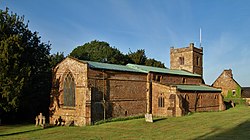Mollington, Oxfordshire
| Mollington | |
| Oxfordshire, Warwickshire | |
|---|---|
 All Saints' parish church | |
| Location | |
| Grid reference: | SP440473 |
| Location: | 52°7’23"N, 1°21’28"W |
| Data | |
| Population: | 479 (2011) |
| Post town: | Banbury |
| Postcode: | OX17 |
| Dialling code: | 01295 |
| Local Government | |
| Council: | Cherwell |
| Parliamentary constituency: |
Banbury |
Mollington is a village on the border of Oxfordshire and Warwickshire, about four miles north of Banbury. The bulk of the village and its centre are in Oxfordshire, but county border crosses Main Street leaving the westernmost streets in Warwickshire; and indeed a small detached part of Northamptonshire takes in the easternmost houses. The 2011 Census recorded the parish's population as 479.
Contents
Name
An Anglo-Saxon will from AD 1015 records the name as Mollintun and the Domesday Book of 1086 records it as Molitone and Mollitone. An entry for 1220 in the Book of Fees records it as Mulinton and a pipe roll from 1230 records it in its modern form of Mollington. It is understood to be derived from Old English Mollan tun, meaning the Moll's village, or Mollinga tun, meaning 'village of Molla's people'.[1]
History
Æthelstan Ætheling, eldest son of Æthelred the Unready willed an estate at Mollington to his father in 1014 or 1015.[2]
The Domesday Book records that by 1086 the manor was held by William d'Évreux, a kinsman of William the Conqueror.[2]
In 1872 a National School was built in the village. It was a Church of England school and was still open in 1996, but has since been closed.
Mollington used to have a post office.[2]
A Point to point racing ground opened at Mollington in 1972. A number of hunt groups were based at the ground until its closure in 2007.[3] It has since reopened with its first event on 7 May 2012.
Church and chapel
Church of England
The earliest parts of the Church of England parish church, All Saints date from the 14th century, but the font is 13th century so there may have been an earlier church building on the site.[2][4] All Saints' has a north aisle which is linked to the nave by an arcade of four bays. The tower was built in the 16th century. There was a chapel on the north side of the chancel, but it was demolished in 1786. A blocked arch and doorway survive in the north wall of the chancel and a piscina can be seen from the outside.[5]
The building was restored in 1856 under the direction of the Gothic Revival architect William White.[6] All Saints' is a Grade II* listed building.[7]
The tower has a ring of six bells.
All Saints' parish is now part of the Benefice of Shires' Edge, along with the parishes of Claydon, Cropredy, Great Bourton and Wardington.
Primitive Methodist and Brethren
In 1817 a private house in Mollington was registered for non-conformist worship. Houses were registered for Methodist worship in 1821 and 1828. A Primitive Methodist minister preached in Mollington in 1835, and a red brick chapel of that denomination was built in the village in 1845. It thrived the 1850s, 60s and 70s but declined in the first half of the 20th century, and was closed in 1947.
The chapel was bought in 1950 for Brethren worship, but closed again by 1969.[2] It is now a private house.[8]
About the village
Mollington has a public house, The Green Man, that was probably built in the middle of the 18th century.[9] It also has a village hall[10] and two children's playgrounds.
Outside links
| ("Wikimedia Commons" has material about Mollington, Oxfordshire) |
References
- ↑ Ekwall 1960, Mollington.
- ↑ 2.0 2.1 2.2 2.3 2.4 Crossley 1972, p. 197–206.
- ↑ Smith, Russell (19 July 2007). "POINT TO POINT: Mollington set to close". Oxford Mail (Newsquest). http://www.oxfordmail.net/search/display.var.1556106.0.point_to_point_mollington_set_to_close.php.
- ↑ Archbishops' Council. "Mollington: All Saints". A Church Near You. Church of England. https://www.achurchnearyou.com/church/5948/.
- ↑ Sherwood & Pevsner 1974, p. 711.
- ↑ Sherwood & Pevsner 1974, p. 710.
- ↑ National Heritage List 1228026: Church of All Saints (Grade II* listing)
- ↑ "Mollington". Oxfordshire Churches & Chapels. Brian Curtis. http://www.oxfordshirechurches.info/MollingtonPrimitiveMethodist.htm.
- ↑ National Heritage List 1216574: The Green Man Public House (Grade II listing)
- ↑ Mollington Village Hall Oxfordshire
- A History of the County of Oxford - Volume 10 pp 197-206: (Victoria County History)
- Ekwall, Eilert, The Concise Oxford Dictionary of English Place-Names. Oxford, Oxford University Press, 4th edition, 1960. ISBN 0198691033
- Nikolaus Pevsner: The Buildings of England: Oxfordshire, 1974 Penguin Books ISBN 978-0-300-09639-2

